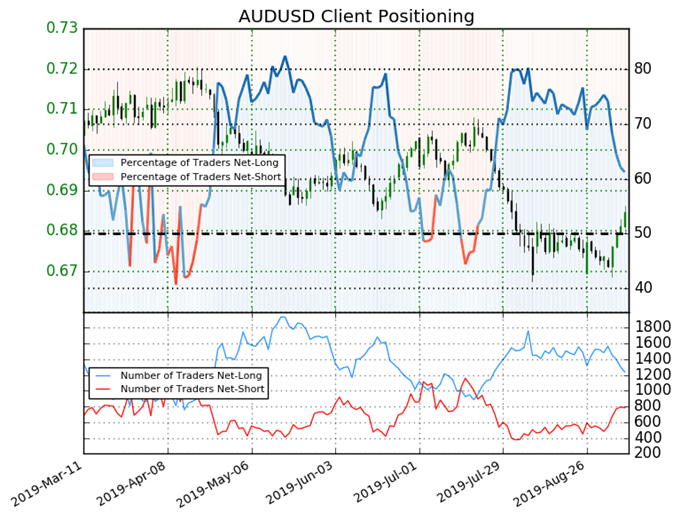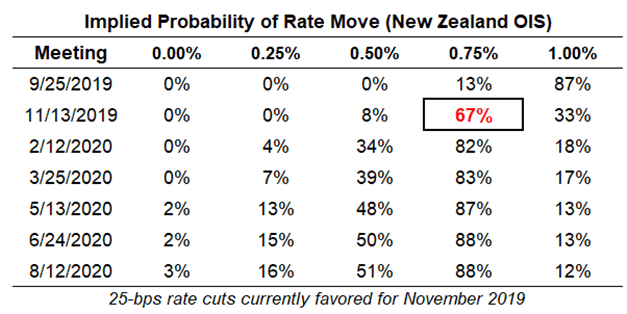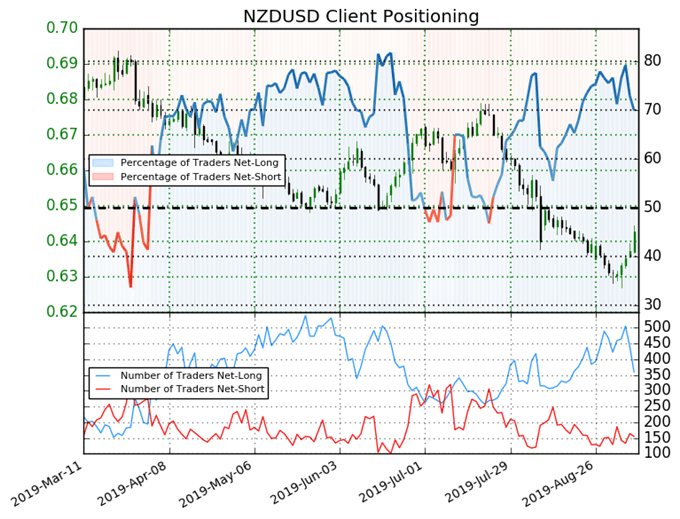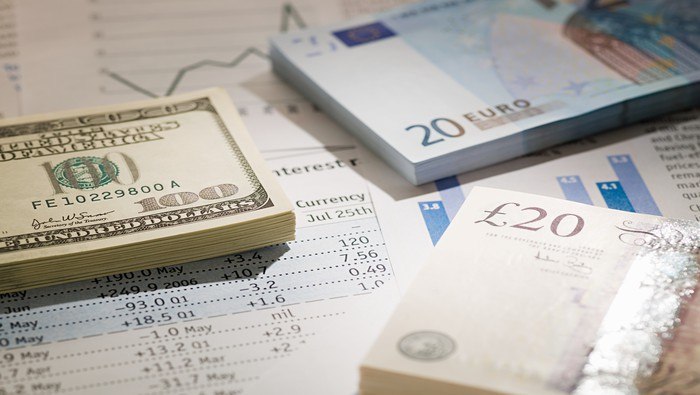Central Bank Weekly Overview
- As the world’s two largest economies move to resolve their trade dispute, expectations for more easing from the G10 currencies’ central banks have receded. In particular, the timing of the next interest rate cuts from the Reserve Bank of Australia and Reserve Bank of New Zealand has been pushed back by one month each.
- Meanwhile, after the September Bank of Canada meeting, rates markets are now pricing in the first BOC rate cut to come in January 2020 – a significant departure from previous expectations.
- Retail trader positioning suggests AUDUSD rates and NZDUSD rates may rally while USDCAD rates may fall.
Looking for longer-term forecasts on the US Dollar? Check out the DailyFX Trading Guides.
Here we are again. Global financial markets are taking another spin around the ‘trade war news cycle’ thanks to the latest call for truce in the US-China trade war. As we’ve previously noted, the cycle goes: (1) Trump administration is tough on China; (2) financial markets sell off on trade war concerns; (3) Trump administration hints at US-China trade deal; (4) financial markets rally on trade deal hopes; (5) No deal materializes.
Now that we’re comfortably in stage (4), traders have seen global equities rally, sovereign bond yields rise, safe haven currencies fall, and precious metals selloff. In a similar vein, fading concerns that the US-China trade war would lead to an acute slowdown in global growth have given market participants good reason (for now) to reduce their expectations for more stimulus from central banks. The “race to the bottom” has been put on hold, for now.
US-China Trade War Truce Reduces Easing Expectations
In turn, as the world’s two largest economies move to resolve their trade dispute,expectations for immediate interest rate cuts from the G10 currencies’ central banks have receded. For the higher yielding and high beta commodity currencies – the Australian Dollar, Canadian Dollar, and New Zealand Dollar – this may be providing cover to claw back losses after a very difficult end of summer.
BOC Rate Cut Not Expected to Arrive Until January 2020
The September BOC meeting had a 7% chance of a producing a 25-bps rate cut, according to overnight index swaps coming into this week. Similarly, there was a 73% chance of a 25-bps rate cut by the end of the year.
Bank of Canada Interest Rate Expectations (September 6, 2019) (Table 1)

But following the latest twists in the US-China trade, the September BOC meeting, and the August Canada jobs report, expectations for looser monetary policy have been trimmed significantly. Now, overnight index swaps are pricing in a 41% chance of a 25-bps rate cut by the end of the year. Indeed, no more rate cuts are expected for 2019; the first may arrive in January 2020 (79% chance).
Read more: Crude Oil Price Stability Gives Room for USD/CAD Selloff - Can it Last?
IG Client Sentiment Index: USDCAD Rate Forecast (September 6, 2019) (Chart 1)

USDCAD: Retail trader data shows 43.3% of traders are net-long with the ratio of traders short to long at 1.31 to 1. In fact, traders have remained net-short since July 23 when USDCAD traded near 1.3051; price has moved 0.9% higher since then. The number of traders net-long is 7.6% lower than yesterday and 25.7% higher from last week, while the number of traders net-short is 5.7% lower than yesterday and 31.5% lower from last week.
We typically take a contrarian view to crowd sentiment, and the fact traders are net-short suggests USDCAD prices may continue to rise. Traders are further net-short than yesterday and last week, and the combination of current sentiment and recent changes gives us a stronger USDCAD-bullish contrarian trading bias.
RBA Rate Cut Less Likely in October, More Likely in November 2019
Australia’s largest two trading partners remain engaged in a trade war of attrition. But with signs that both sides are trying to de-escalate in the short-term, the Australian Dollar has been able to claw back some of its recent losses after an August to forget. With the Australian current account rising into surplus sharply in recent quarters, there are tectonic forces that beginning to support a stronger Australian Dollar long-term. That there is a pause in the US-China trade war may be enough for the Reserve Bank of Australia to hold off on cutting rates in the near-term, given the otherwise positive fiscal backdrop.
Reserve Bank of Australia Interest Rate Expectations (September 6, 2019) (Table 2)

The RBA is increasingly likely to keep interest rates on hold when it meets in October. At the end of last week, and prior to the September RBA meeting, rates markets were pricing in a 64% chance of a 25-bps rate cut at the October RBA meeting. Now, overnight index swaps are discounting a 44% chance of a 25-bps rate cut next month. If the RBA is going to cut rates again this year, markets favor the November 2019 meeting (73% chance).
IG Client Sentiment Index: AUDUSD Rate Forecast (September 6, 2019) (Chart 2)

AUDUSD: Retail trader data shows 61.3% of traders are net-long with the ratio of traders long to short at 1.58 to 1. In fact, traders have remained net-long since July 19 when AUDUSD traded near 0.7019; price has moved 2.4% lower since then. The percentage of traders net-long is now its lowest since July 19 when AUDUSD traded near 0.70394. The number of traders net-long is 11.2% lower than yesterday and 20.5% lower from last week, while the number of traders net-short is 1.6% higher than yesterday and 52.0% higher from last week.
We typically take a contrarian view to crowd sentiment, and the fact traders are net-long suggests AUDUSD prices may continue to fall. Yet traders are less net-long than yesterday and compared with last week. Recent changes in sentiment warn that the current AUDUSD price trend may soon reverse higher despite the fact traders remain net-long.
RBNZ Rate Cut Timing Pushed Back from September to November 2019
The New Zealand Dollar was the worst performing G10 currency in August as mounting interest rate cut speculation coincided with rising concerns about the US-China trade war, exacerbating the selloff in higher yielding and high beta currencies.
But with the US-China trade war reduced from a boil to a simmer, the immediate need to provide stimulus for economies caught in the undertow of the trade dispute has dissipated. Even as New Zealand economic data has started to underperform – the New Zealand Citi Economic Surprise Index is down from 37.4 to 20.6 over the past four weeks – expectations around the timing of the next RBNZ interest rate cut have been pushed back.
Reserve Bank of New Zealand Interest Rate Expectations (September 6, 2019) (Table 3)

According to overnight index swaps, the RBNZ will no longer cut rates in September; odds of a 25-bps rate cut have fallen to 13%. Instead, the timing of the next rate cut has been pushed back by one month: there is a 67% chance of a 25-bps rate cut in November, the last RBNZ policy meeting of 2019. Another 25-bps rate cut is on the horizon as well, but it’s too soon to say that markets are confident that another policy shift will indeed occur: there is a 50% of a 25-bps rate cut by June 2020.
IG Client Sentiment Index: NZDUSD Rate Forecast (September 6, 2019) (Chart 3)

NZDUSD: Retail trader data shows 69.9% of traders are net-long with the ratio of traders long to short at 2.32 to 1. In fact, traders have remained net-long since July 23 when NZDUSD traded near 0.6732; price has moved 4.5% lower since then. The number of traders net-long is 24.4% lower than yesterday and 19.5% lower from last week, while the number of traders net-short is 2.6% higher than yesterday and 0.6% higher from last week.
We typically take a contrarian view to crowd sentiment, and the fact traders are net-long suggests NZDUSD prices may continue to fall. Yet traders are less net-long than yesterday and compared with last week. Recent changes in sentiment warn that the current NZDUSD price trend may soon reverse higher despite the fact traders remain net-long.
Read more: US Recession Watch, September 2019 - Growth Weak Even as US Treasury Yield Curve Steepens
FX TRADING RESOURCES
Whether you are a new or experienced trader, DailyFX has multiple resources available to help you: an indicator for monitoring trader sentiment; quarterly trading forecasts; analytical and educational webinars held daily; trading guides to help you improve trading performance, and even one for those who are new to FX trading.
--- Written by Christopher Vecchio, CFA, Senior Currency Strategist
To contact Christopher Vecchio, e-mail at cvecchio@dailyfx.com
Follow him on Twitter at @CVecchioFX
View our long-term forecasts with the DailyFX Trading Guides




